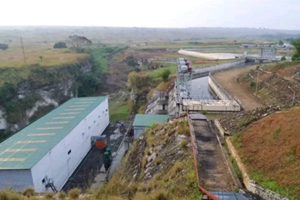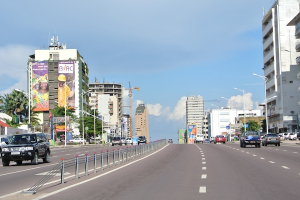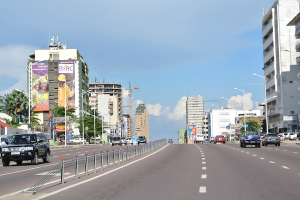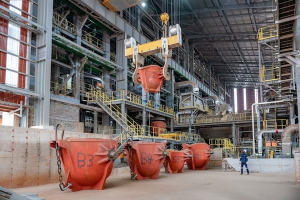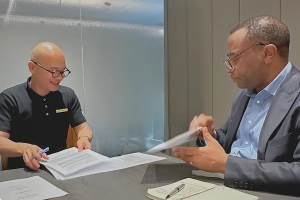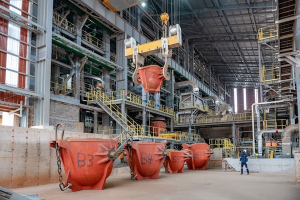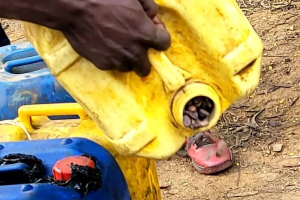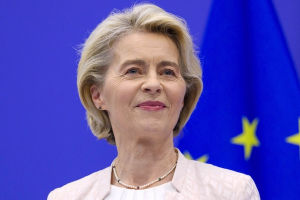Equipe Publication
Centrale de Kakobola : mise en service prévue d’ici janvier
Lors de son passage au Forum Makutano, le 26 novembre 2025, le ministre des Ressources hydrauliques et de l’Électricité, Aimé Sakombi Molendo, a annoncé la mise en service de la centrale hydroélectrique de Kakobola (10,5 MW), dans les 47 prochains jours, soit d’ici janvier 2026. Cette infrastructure, dont les travaux ont été lancés en 2010, doit alimenter les villes de Kikwit, Idiofa et Gungu, ainsi que les missions catholiques de Totshi et Aten, et le village de Butshamba, dans la province du Kwilu.
« Il y a une note qui passe ce vendredi en Conseil des ministres sur le choix de l’exploitant. Il y avait beaucoup de juridisme. Pour aller de l’avant, nous avons demandé au gouvernement de nous autoriser à recourir à l’article 39 sur l’entente directe. Comme ça, tout est nettoyé et l’exploitant peut directement reprendre cette centrale », a-t-il précisé.
À l’en croire, les derniers prérequis techniques et financiers ont été levés grâce à l’intervention directe du président de la République, ouvrant la voie à la finalisation du projet.
Sur le terrain, le raccordement des ménages et des entreprises se poursuit. La construction des lignes de transport et des réseaux de distribution avait été annoncée lors du Conseil des ministres du 23 mai 2025.
Le ministre a également indiqué que, dans la perspective du lancement, une itinérance du chef de l’État est prévue entre le 9 et le 13 décembre dans la zone de Kakobola. Cette visite devrait marquer l’une des dernières étapes institutionnelles avant la mise en service effective de l’infrastructure.
Boaz Kabeya
Lire aussi :
Centrale de Kakobola (10,5 MW) : le chantier en phase finale, 15 ans après son lancement
Kinshasa Announces New Expressway to Ease Access to Ndjili Airport
The Democratic Republic of Congo will begin construction in January 2026 on a new highway to link Kinshasa's city center to Ndjili International Airport, Transport Minister Jean-Pierre Mbemba announced on Nov. 26.
The project, announced at the Makutano forum, aims to reduce a journey that can often take several hours.
“The plan is to build a highway starting from Triumphal Boulevard, running through Sendwe, June 30 Boulevard, Limete and Lumumba Boulevard all the way to the airport,” Mbemba said. “We will widen the existing roads, build tunnels in some sections and flyovers in others.”
According to the minister, the longest structure will stretch 1.2 kilometers and will be built in the Tshangu area.
Mbemba added that the project was approved by the Council of Ministers about six weeks ago, and the Congolese Agency for Major Public Works is now carrying out technical studies. He also said a second highway project is being prepared, with more details to be released once it reaches a more advanced stage.
Boaz Kabeya
Kinshasa : une voie rapide annoncée pour fluidifier l’accès à l’aéroport
Rallier l’aéroport international de N’Djili à partir du centre administratif de Kinshasa peut parfois prendre plusieurs heures. Pour réduire ce délai, le ministre des Transports, Jean-Pierre Mbemba, a annoncé, le 26 novembre 2025 lors du forum Makutano, le démarrage en janvier 2026 des travaux d’aménagement d’une voie rapide reliant le centre de Kinshasa à l’aéroport.
« L’idée, c’est de pouvoir créer une voie rapide à partir du boulevard Triomphal, en passant par Sendwe, le boulevard du 30 Juin, Limete, le boulevard Lumumba jusqu’à l’aéroport. On va élargir les routes et, sur certains tronçons, des tunnels vont être créés et sur d’autres des flyovers (ponts) ». L’ouvrage le plus long fera 1,2 km et sera érigé du côté de la Tshangu, a précisé le ministre.
Selon Jean-Pierre Mbemba, le projet a été validé par le Conseil des ministres il y a un mois et demi, et l’Agence congolaise des grands travaux (ACGT) réalise actuellement les études techniques. Il a également indiqué qu’un deuxième projet de voie rapide est en préparation, dont les détails seront communiqués après sa phase de maturation.
Boaz Kabeya
Lire aussi :
Kinshasa : reprise du trafic sur le boulevard Lumumba, principal accès à l’aéroport
DR Congo Water Utility REGIDESO Agrees To Digital Overhaul With Singapore’s EFGH
Singapore-based Embed Financial Group Holdings (EFGH) said on Nov. 20 it signed a master services agreement with the Water Distribution Authority (REGIDESO SA) to accelerate the utility’s digital transformation, including modernizing how it collects payments from households and businesses.
According to the statement, REGIDESO and EFGH will jointly develop secure digital channels for bill payments, security features and new financial tools designed to simplify and speed up payments and make them more accessible. The initiative aims to improve payment tracking, enhance transparency, strengthen investor confidence and help REGIDESO raise capital to finance its modernization.
REGIDESO already offers digital payment services. Information on its website shows that customers can pay bills through a mobile app available on the App Store and Google Play or via its website. These services currently cover 11 of the DRC’s 26 provinces. For customers without internet access, a USSD code is also available.
EFGH describes itself as a specialist in digital payments, financial platforms and digital ecosystems. The company said it operates in several African markets, including Ghana, where on Oct. 29 it announced a joint venture with the District Assemblies Common Fund (DACF). That partnership aims to build a “Finternet,” a digital financial infrastructure designed to connect governments, residents and businesses. According to EFGH, this Finternet will link payments, credit and insurance the way the internet links information, helping Ghanaian districts manage funds and public services more effectively while creating new revenue streams.
Timothée Manoke
Kamoa-Kakula Power Demand To Reach 347 MW In 2028, Ivanhoe Mines Says
The electricity demand for the Kamoa-Kakula copper complex in Lualaba province, operated by Kamoa Copper SA, is projected to rise significantly in the coming years. According to projections published by its developer Ivanhoe Mines, total demand will reach 347 MW by December 2028, up from 208 MW in December 2025.
The figures come from an internal projection table included in a Nov. 25 statement announcing the commissioning of the rehabilitated turbine No. 5 at the Inga II dam. They differ from the forecasts Ivanhoe Mines presented last April.
The site began receiving an initial 50 MW from the dam, which has an installed capacity of 178 MW, on Nov. 10, the statement said. This power supply will gradually increase to 100 MW in the first quarter of 2026 and to around 150 MW in 2027 as optimizations to the Inga-Kolwezi grid are completed.
A $450 million investment is expected to bring the national utility Snel's contribution to the complex's power supply to 210 MW by the end of 2027. In addition to this capacity, Kamoa Copper SA plans to maintain 100 MW of electricity imports, supplemented by 60 MW from two on-site solar projects under development. The company said this gives it a supply of clean energy that exceeds its needs, cementing its status as a copper producer with one of the lowest greenhouse gas emissions in the industry.
The statement did not explain the projections in detail. But the numbers indicate the site is not expected to reach its high-production scenario before 2028. According to Ivanhoe Mines documentation, that scenario corresponds to an energy demand exceeding 300 MW, involving the simultaneous operation of three concentrators, the full ramp-up of the electric smelter, and the metallurgical optimization of "Project 95." This would yield an annual production of nearly 550,000 to 600,000 tons of copper concentrate.
This implies that the electric smelter, commissioned on Nov. 21 after several delays, will only operate at its rated capacity of 500,000 tons of concentrate per year as 2028 approaches.
Following seismic activity in the Kakula underground mine, production forecasts and the smelter ramp-up schedule have been withdrawn pending a re-evaluation. Kamoa Copper SA has since lowered its 2025 production forecast to between 370,000 and 420,000 tons, down from an initial range of 520,000 to 580,000 tons. Forecasts for future years and a definitive smelter ramp-up schedule are still pending.
The commissioning of the Kamoa-Kakula smelter, described as the largest and most modern in Africa, is a strategic milestone for the Congolese economy. It allows the country to transition from exporting concentrate to exporting copper metal, increasing the value captured locally, fiscal revenues, industrial development, and the DRC's influence in the global copper supply chain.
Pierre Mukoko
REGIDESO : un accord avec le Singapourien EFGH pour moderniser la collecte des recettes
L’entreprise Embed Financial Group Holdings (EFGH), basée à Singapour, a annoncé avoir signé, le 20 novembre, un accord-cadre de services avec la Régie de distribution d’eau (REGIDESO SA) visant à accélérer la transformation numérique de l’entreprise publique, notamment en modernisant le recouvrement des recettes auprès des ménages et des entreprises.
Selon l’annonce, la REGIDESO et EFGH développeront ensemble des canaux numériques sécurisés pour le paiement des factures, des dispositifs de protection ainsi que de nouveaux outils financiers destinés à simplifier, accélérer et rendre les paiements plus accessibles au public. L’objectif affiché est clair : faciliter et tracer les paiements, renforcer la transparence, accroître la confiance des investisseurs et, à terme, permettre à la REGIDESO de lever des capitaux pour financer sa modernisation.
La REGIDESO propose déjà des solutions de paiement digital à ses abonnés. D’après les informations publiées sur son site et ses canaux officiels, il est possible de régler ses factures via une application mobile disponible sur App Store et Google Play, ou encore via le site web de l’entreprise. À ce stade, ces services couvrent 11 provinces sur les 26 que compte la RDC. Pour les abonnés ne disposant pas d’accès à Internet, un code USSD est également disponible, permettant une utilisation simple depuis n’importe quel téléphone mobile.
Du côté d’EFGH, l’entreprise singapourienne se présente comme spécialiste des paiements numériques, des plateformes financières et de la conception d’écosystèmes digitaux. Elle affirme opérer dans plusieurs pays africains, dont le Ghana où elle a annoncé, le 29 octobre dernier, une joint-venture avec la Ghana’s District Assemblies Common Fund (DACF). Ce partenariat porte sur le développement d’une « Finternet », une infrastructure financière numérique destinée à connecter gouvernements, populations et entreprises. Selon EFGH, cette Finternet reliera paiements, crédit et assurance de la même manière qu’Internet relie l’information, afin de permettre aux districts ghanéens de gérer plus efficacement les fonds et les services publics, tout en créant de nouvelles sources de revenus pour le développement national.
Timothée Manoke.
Lire aussi :
Pollution à Lubumbashi: la REGIDESO affirme que l’eau du réseau reste potable
Kamoa-Kakula : la demande électrique projetée à 347 MW d’ici fin 2028
La demande d’électricité du complexe cuprifère Kamoa-Kakula, situé dans la province du Lualaba et opéré par Kamoa Copper SA, devrait augmenter de manière significative dans les prochaines années. Selon les projections publiées par son développeur Ivanhoe Mines, la demande totale atteindra 347 MW en décembre 2028, contre 208 MW en décembre 2025.
Ces chiffres proviennent d’un tableau de projection interne repris dans le communiqué du 25 novembre 2025 annonçant la mise en service de la turbine n°5 d’Inga II, réhabilitée par la Société nationale d’électricité (Snel) avec l’appui de Kamoa Copper. Ils diffèrent des prévisions qu’Ivanhoe Mines avait présentées en avril dernier.
Selon ce communiqué, le site a commencé à recevoir, le 10 novembre dernier un premier lot de 50 MW en provenance de cette infrastructure d’une capacité installée de 178 MW. Cette puissance doit progressivement augmenter pour atteindre 100 MW dès le premier trimestre 2026, puis environ 150 MW en 2027, à mesure que les optimisations du réseau Inga–Kolwezi seront finalisées.
Offre et demande énergétique du complexe Kamoa-Kakula (2025-2028)
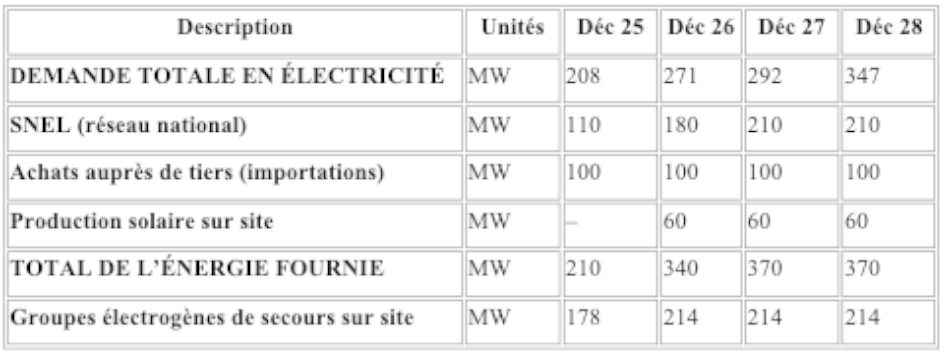
Cet investissement — évalué à 450 millions de dollars — devrait porter à 210 MW la contribution nationale (Snel) à l’alimentation du complexe à fin 2027. Outre cette capacité, Kamoa Copper SA prévoit de maintenir 100 MW d’importations d’électricité, auxquels s’ajouteront 60 MW issus de deux projets solaires en développement sur le site. L’entreprise assure ainsi disposer d’une offre en énergie propre supérieure à ses besoins, consolidant son statut de producteur de cuivre aux émissions de gaz à effet de serre parmi les plus faibles de l’industrie.
Le communiqué n’explique pas en détail ces projections. Mais ces chiffres montrent que le site ne devrait pas atteindre son scénario de production élevé avant 2028. Selon la documentation d’Ivanhoe Mines, ce scénario correspond à une demande énergétique dépassant 300 MW, impliquant le fonctionnement simultané des trois concentrateurs, la montée en régime complète de la fonderie électrique et l’optimisation métallurgique du Projet 95 — soit une production annuelle proche de 550 000 à 600 000 tonnes de concentré de cuivre.
Mise en service de la fonderie
Cela implique que la fonderie électrique, mise en service le 21 novembre dernier après plusieurs reports, ne devrait fonctionner à sa capacité nominale de 500 000 tonnes de concentrés par an qu’à l’approche de 2028.
À la suite de l’activité sismique survenue dans la mine souterraine de Kakula, les prévisions de production et le calendrier de montée en puissance de la fonderie ont depuis été retirés dans l’attente d’une réévaluation. Kamoa Copper SA a depuis abaissé ses prévisions pour 2025 : la production est désormais attendue entre 370 000 et 420 000 tonnes, contre une fourchette initiale de 520 000 à 580 000 tonnes. Mais les prévisions pour les années à venir restent attendues, de même que le calendrier définitif de montée en régime de la fonderie.
La mise en service de la fonderie de Kamoa-Kakula — présentée comme la plus grande et la plus moderne d’Afrique — marque un tournant stratégique pour l’économie congolaise : elle permet au pays de passer de l’exportation du concentré à celle du cuivre métal, augmentant la valeur ajoutée captée localement, les recettes fiscales, le développement industriel et l’influence de la RDC dans la chaîne mondiale du cuivre.
Pierre Mukoko
Lire aussi :
Inga II : 50 MW attendus dès novembre pour Kamoa-Kakula
Électricité : Kamoa Copper projette d’installer 120 MW de solaire sur son site minier
Kamoa-Kakula : vers un maintien des revenus à 3 milliards $ malgré l’incident sismique
DR Congo’s North Kivu to Sell Seized Cocoa to Fund Infrastructure
The North Kivu military governor's office in the Democratic Republic of Congo said on Tuesday that intercepted cocoa shipments, seized while attempting to cross the border illegally, will now be sold with the revenue used to build provincial infrastructure.
David Kamuha, chief of staff for the military governor, announced the policy during a ceremony presenting seized cocoa to provincial executives, according to a Nov. 25 publication from the governorship.
At the ceremony, control services presented a FUSO truck which Kamuha said was carrying fraudulent cocoa, along with 16 canisters supposedly containing palm oil but actually used to conceal cocoa destined for clandestine transport to Uganda.
The quantities currently held by provincial services were not revealed. However, available data illustrates the scale of the phenomenon. In early November, Kakule Justin, head of the National Office of Agricultural Products of Congo (ONAPAC) at the Kasindi border post, said 118 tons of cocoa had been intercepted in five months by control services.
He said smugglers operate mainly at night, using tracks that evade surveillance.
According to the official, the seized products mostly come from plantations in the Ruwenzori, Mutwanga and Bulongo sectors, areas with significant cocoa activity. The traders supplying these clandestine networks are seeking the slightly higher prices offered in Uganda, to the detriment of legal channels. This smuggling deprives the Democratic Republic of Congo of thousands of dollars in tax revenue, according to ONAPAC, while weakening the domestic cocoa market.
Timothée Manoke
Nord-Kivu : le cacao saisi aux frontières désormais vendu pour financer les infrastructures
Lors d’une cérémonie de présentation à l’exécutif provincial des lots de cacao saisis par les services de la province, David Kamuha, directeur de cabinet du gouverneur militaire, a annoncé que les cargaisons interceptées alors qu’elles tentaient de traverser illicitement la frontière seront désormais vendues. Les recettes de ces ventes seront affectées à la construction d’infrastructures dans la province. C’est ce qui ressort d’une publication du gouvernorat datée du 25 novembre 2025.
Au cours de cette cérémonie, les services de contrôle ont notamment présenté un camion de marque FUSO qui, selon le directeur de cabinet, transportait du cacao frauduleux, ainsi que 16 bidons censés contenir de l’huile de palme mais utilisés en réalité pour dissimuler du cacao destiné à être acheminé clandestinement vers l’Ouganda.
#Beni Des cacaos frauduleux transportés sur la RN4 ont été interceptés au poste frontière de #Kasindi par les services attitrés. Aussitôt après, la cargaison saisie a été retournée au Gouvernorat. Le Dircab du Gouverneur David Kamuha a fait le constat. pic.twitter.com/0VRohd0jAh
— Gouvernorat|Nord-Kivu🇨🇩 (@GouvNordKivu) November 25, 2025
Même si les quantités actuellement détenues par les services provinciaux n’ont pas été révélées, les données disponibles illustrent l’ampleur du phénomène. Au début du mois de novembre, Kakule Justin, chef de bureau de l’Office National des Produits Agricoles du Congo (ONAPAC) au poste frontalier de Kasindi, indiquait que 118 tonnes de cacao avaient été interceptées en cinq mois par les services de contrôle. Il précisait que les fraudeurs opèrent essentiellement de nuit, empruntant des pistes échappant à la surveillance.
Selon ce responsable, les produits saisis proviennent majoritairement de plantations des secteurs de Ruwenzori, Mutwanga et Bulongo, zones où l’activité cacaoyère est importante. Les commerçants qui alimentent ces circuits clandestins recherchent les prix légèrement plus élevés proposés en Ouganda, au détriment des circuits légaux. Cette contrebande prive la République démocratique du Congo de milliers de dollars de recettes fiscales, selon l’ONAPAC, tout en fragilisant le marché intérieur du cacao.
Timothée Manoke
Lire aussi :
Cacao : les prix à l’exportation en RDC s’effondre de 40 % en quelques mois
Nord-Kivu : le cacao congolais échappe aux circuits officiels via l’Ouganda
À Ariwara, la contrebande transfrontalière asphyxie l’industrie locale
Commerce avec l’Ouganda : les importations annuelles de la RDC frôlent 1 milliard $
EU’s von der Leyen Highlights Clean Energy Push, Green Corridor Plan in the DRC
European Commission President Ursula von der Leyen has outlined the European Union's priorities in the Democratic Republic of Congo, with clean energy production at the forefront, ahead of the EU-African Union summit in Angola on Nov. 24-25.
"With one of the fastest population growth rates in the world, the demand for electricity is increasing faster than existing infrastructure," the president of the European Commission said.
She said the EU is focusing its support on five major conservation areas, Garamba, Salonga, Virunga, Upemba and Yangambi, which she said hold significant potential for developing clean energy accessible to local communities.
Regarding electricity access in the Northeast, von der Leyen said the EU supports extending the grid to Kisangani and improving supply reliability to secure access for millions of Congolese.
The president also highlighted the "Green Corridor" initiative, integrated into the Global Gateway strategy. It plans to create a protected area of more than 544,000 square kilometers stretching from eastern DRC to Kinshasa, combining the preservation of primary forests, sustainable economic development and the creation of 500,000 jobs, some of which are intended for demobilized youth.
She also emphasized the role of the Lobito Corridor, which has become a central tool for supporting hydroelectric and solar projects, rural electrification and the reduction of regional emissions, in line with international climate commitments.
Finally, von der Leyen placed these actions in a broader continental framework by recalling the launch of the "Scaling Up Renewables in Africa" campaign with South Africa. This initiative mobilized 15.5 billion euros to support access to clean energy for the 600 million Africans who still lack it, with the ambition of creating sustainable economic opportunities.
Von der Leyen, who became the first woman to serve as European Commission president in 2019, is a former German minister and member of the CDU party who steers the EU's broad policy on energy, infrastructure and climate transition.
Boaz Kabeya





